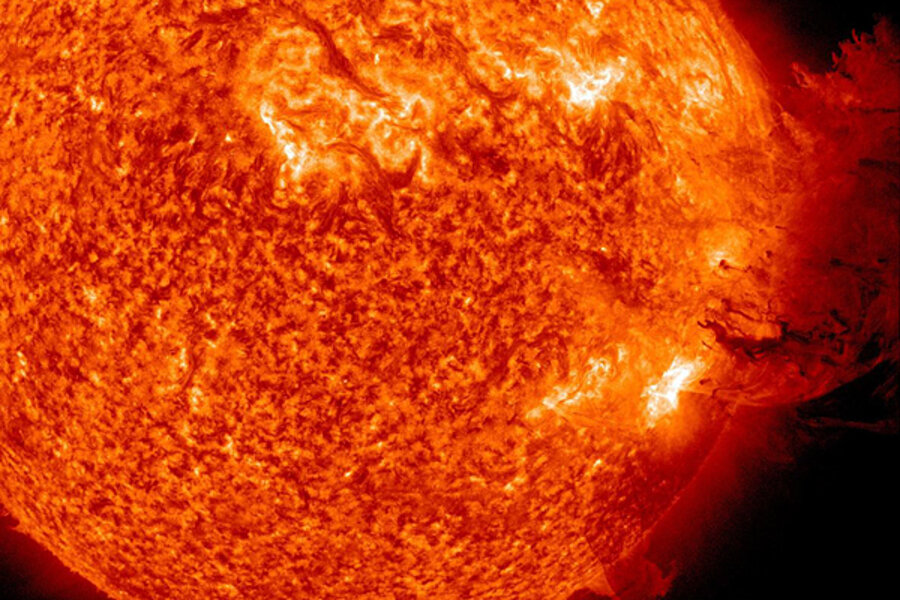Solar storm delivers a glancing blow to Earth – and a warning
Charged particles from a huge solar eruption two days ago delivered only a glancing blow to Earth Thursday.
But it still represented a warning. Solar activity is approaching the 2013 peak of its 11-year cycle, called the "solar maximum," and the developed world finds itself ever more dependent on systems vulnerable to massive solar storms.
Perhaps most important, the power grid is 10 times larger than it was in 1921, when the last solar superstorm hit, effectively making it a giant new antenna for geomagnetic current. A far stronger solar outburst could overload and wreck hundreds of critical high-voltage transformers nationwide, blacking out 130 million people for months and costing as much as $2 trillion, according to an Oak Ridge National Laboratory study.
"When we look back through history, we can see the thumbprint of these extreme events that were a lot worse in their intensity than anything seen in the modern space era," says Daniel Baker, director of the Laboratory for Atmospheric and Space Physics at the University of Colorado at Boulder, who chaired a seminal 2008 National Research Council study on solar weather's impact on the North American power grid.
As “society is becoming more and more dependent on vulnerable systems like the power grid,” he adds, it is “dramatically increasing its vulnerability every few years."
The first confirmed "solar tsunami" occurred in 1859. British astronomer Richard Carrington was busily sketching sunspots through his telescope when he observed a brilliant, oval-shaped light erupting from the sun that lasted several minutes.
Days later, telegraph systems worldwide went haywire. There was so much geomagnetically induced current on the lines that some telegraph operators reported being able to use the systems without batteries. In other cases, telegraph offices caught fire and wires melted. The northern lights could be seen as far south as Cuba.
More than 150 years later, the US and most other nations are not well prepared to weather a truly massive solar storm like the "Carrington event," many experts say.
The threat, however, is gaining attention.
The White House and the British government last month unveiled plans to collaborate on a space weather warning system that would improve predictions. Early this year, the National Oceanic and Atmospheric Administration announced that a new computer modeling system to predict space weather would be operational this fall. The idea is to give power-grid operators and others ample time and certainty to prepare in advance of a solar storm.
"We're certainly getting better at it," says Jeffrey Hughes, director of the Center for Integrated Space Weather Modeling at Boston University, which developed the NOAA computer-modeling system. "A big solar event is kind of like a hurricane in the mid-Atlantic – it's hard to see whether it's going to hit Florida or not.”
“We see this coronal mass ejection leave the sun, but then it's very hard to track, because we can't see it,” he adds. “We can see it near the sun, but thereafter we are projecting with computer models."
For its part, the Federal Energy Regulatory Commission (FERC) is urging Congress to include in legislation intended to secure the grid from cyberattack parallel authority to protect it from severe solar geomagnetic storms.
"In my view, any legislation on national security threats to reliability [of the power grid] should address not only cybersecurity threats but also natural events, i.e., a [solar] geomagnetic disturbance,” Joseph McClelland, director of the FERC's office of electric reliability, testified to a Senate committee in May.
Hardening the grid against natural solar events would require about 5,000 devices that are, in layman's terms, not unlike surge protectors that block geomagnetic induced current, says John Kappenman, an author of the Oak Ridge National Laboratory study. He puts the price tag at about $1 billion.
"The good news is that there's a solution here," he says.
In his research, Kappenman dug into historical records to examine how previous monster solar storms affected society. Another geomagnetic solar storm occurred in 1921, nearly as strong as the Carrington event.
More recently, a 1989 solar storm – also a coronal mass ejection – knocked out power to millions of people in Quebec for about nine hours. Farther south, a large transformer at the Salem Nuclear Power plant in New Jersey was destroyed by the same event.
"These are, thankfully, low-probability events," Mr. Kappenman says. "But sooner or later they will occur and we can't afford to learn the hard way like do with other natural disasters. We have no ability to just resolve to do a better job on the next one.”
His report suggested that rebuilding from a storm like the Carrington event could take four to 10 years today.
“That's the fundamental difference between this threat scenario and the way we tend to learn from other disasters,” he adds. “This time we need to learn before it happens."





